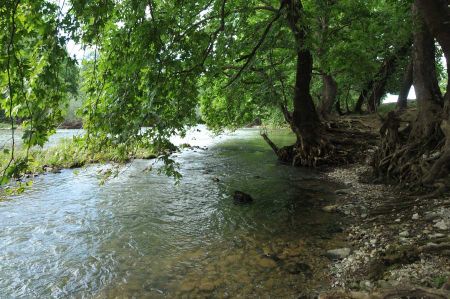Sycamore Trees on Pinios - an idyll at the ancient Salambria
- Written by Portal Editor
Sycamore Trees - Our explorations around the Camper Stop Rapsani has brought us to the shore of the river Pinios, which expands to a large river delta along the coast and thus constitutes a paradise for different species of birds.
Lovers of nature can book boat tours into the Delta or along the coast, can settle for crab fishing at the shore or just enjoy the tranquility of nature. Maybe do a canoe trip from the Camper Stop to the sea, which appears particularly appealing to us after finding the Sycamore Trees along Pinios shore.
Sycamore trees reach heights of 25 to 50 meters
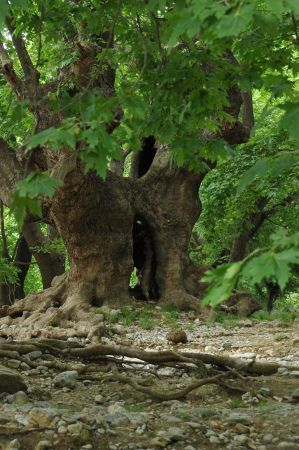 With the optimum location conditions and the type of tree, the here discovered sycamore trees reached heights of 25 to 50 meters, often their mighty trunk circumferences reach several meters.
With the optimum location conditions and the type of tree, the here discovered sycamore trees reached heights of 25 to 50 meters, often their mighty trunk circumferences reach several meters.
The bark annually scrolls in thin plates, leaving behind the typical mosaic of whitish and greenish areas.
Allergy warning: Throughout the growing season, the inhalation of sloping or stripped hair dust may lead to irritation of the bronchial tubes for sensitive people, the sycamore trees are responsible for so-called trigger coughing!
That aside, the viewer finds very interesting growth habits and strong root system, we have not seen before. John and Andrea, who knew mighty tree work from their native Brazil were, just like us, surprised whether the vegetation on Pinios. So mighty and giant trees they did not not expect.
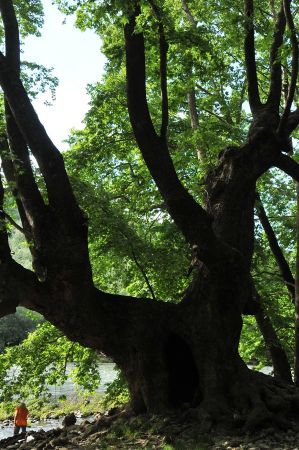 The Pinios river itself with its 217 km of length is one of the mightiest river regions of Thessaly, at all, Pinios is one of the longest rivers of Greece and responsible for draining the lowlands.
The Pinios river itself with its 217 km of length is one of the mightiest river regions of Thessaly, at all, Pinios is one of the longest rivers of Greece and responsible for draining the lowlands.
The Pinios springs from two source rivers of the southern Pindos Mountains. The northern source river Malakasiotiko rises between the village Platanitsos and south of the village Milia on the southeast flank of the mountain Mavrovouni.
East of Metsovo and immediately south of the town Malakasi springs the second source river Baltos from the Northeast foothills of Lakmos massif.
North of the village Matoneri and south of the village of Panagia, the two source rivers unite to be named Malakasiotikos now.
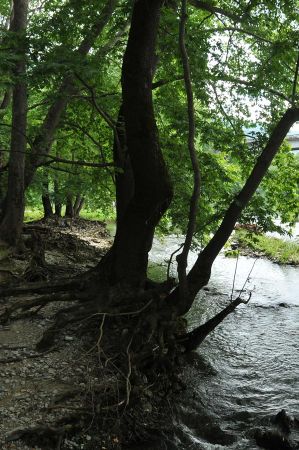 From the gathering with the Ion river further downstream, the river is called Pinios and widens considerably by the aforementioned inflows.
From the gathering with the Ion river further downstream, the river is called Pinios and widens considerably by the aforementioned inflows.
In addition to the widening by the river Pivot about 3 km northwest of Kalambaka, it passes through the city of Kalambaka with the Meteora monasteries in the west and south.
West of Trikala in the village Parapotamos, the Pinios receives yet another influx from the south of Kerketio massif, this river is called Portaikos.
North of the village of Marathea after flowing through the city of Trikala, the Litheos river flows into the Pinios. Located a few kilometers further east, river Neochoritis, located southeast of the ruins of the ancient city Farkadon and southwest of the current city Farkadona, flows into Pinios river too.
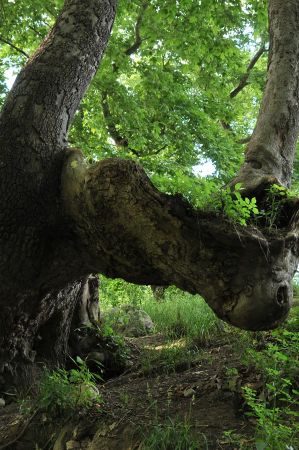 Between the ancient city Gonnoi and the village of Evangelismos, the Pinios occurs flowing direction to east-northeast into the Tembi Valley and flows through this bottleneck between Ossa Mountains to the South and Mount Olympus in the north for a distance of about 8 km.
Between the ancient city Gonnoi and the village of Evangelismos, the Pinios occurs flowing direction to east-northeast into the Tembi Valley and flows through this bottleneck between Ossa Mountains to the South and Mount Olympus in the north for a distance of about 8 km.
The valley here reaches minimum width of 40 m. In addition to the Pinios and its riverbed, the Greek main railway line from Thessaloniki via Larisa to Athens and Motorway 1 use this passage between Olympus and Ossa.
North of the ruins of ancient Omolion, the Pinios divides into two main arms as a mouth and flows into the Aegean Sea at the southern end of the Thermaic Gulf.
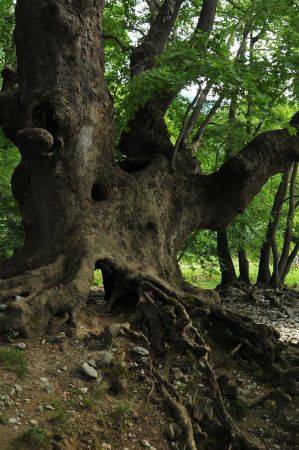 Even now river and surrounding valleys offer numerous possibilities for exploring nature, especially if you like to watch Sycamore trees and flowing water, in spite of the heavy traffic on the route Thessaloniki - Athens.
Even now river and surrounding valleys offer numerous possibilities for exploring nature, especially if you like to watch Sycamore trees and flowing water, in spite of the heavy traffic on the route Thessaloniki - Athens.
With completion of the highway through several tunnels along the Tembi Valley, the region around Rapsani will become a paradise for hikers, wine lovers and nature lovers, especially striking destinations as the Meteora monasteries, the Royal Tombs of Vergina and Olympus are all nearby.
Please read as well:
Rapsani Camperstop - further exploring of surrounding places
The Macedonian Royal Tombs of Vergina
-
 Rapsani - Sycamore Trees at the Pinios
Rapsani - Sycamore Trees at the Pinios
Rapsani - Sycamore Trees at the Pinios
Rapsani - Sycamore Trees at the Pinios
-
 Rapsani - Sycamore Trees at the Pinios
Rapsani - Sycamore Trees at the Pinios
Rapsani - Sycamore Trees at the Pinios
Rapsani - Sycamore Trees at the Pinios
-
 Rapsani - Sycamore Trees at the Pinios
Rapsani - Sycamore Trees at the Pinios
Rapsani - Sycamore Trees at the Pinios
Rapsani - Sycamore Trees at the Pinios
-
 Rapsani - Sycamore Trees at the Pinios
Rapsani - Sycamore Trees at the Pinios
Rapsani - Sycamore Trees at the Pinios
Rapsani - Sycamore Trees at the Pinios
-
 Rapsani - Sycamore Trees at the Pinios
Rapsani - Sycamore Trees at the Pinios
Rapsani - Sycamore Trees at the Pinios
Rapsani - Sycamore Trees at the Pinios
-
 Rapsani - Sycamore Trees at the Pinios
Rapsani - Sycamore Trees at the Pinios
Rapsani - Sycamore Trees at the Pinios
Rapsani - Sycamore Trees at the Pinios
-
 Rapsani - Sycamore Trees at the Pinios
Rapsani - Sycamore Trees at the Pinios
Rapsani - Sycamore Trees at the Pinios
Rapsani - Sycamore Trees at the Pinios
-
 Rapsani - Sycamore Trees at the Pinios
Rapsani - Sycamore Trees at the Pinios
Rapsani - Sycamore Trees at the Pinios
Rapsani - Sycamore Trees at the Pinios
-
 Rapsani - Sycamore Trees at the Pinios
Rapsani - Sycamore Trees at the Pinios
Rapsani - Sycamore Trees at the Pinios
Rapsani - Sycamore Trees at the Pinios
-
 Rapsani - Sycamore Trees at the Pinios
Rapsani - Sycamore Trees at the Pinios
Rapsani - Sycamore Trees at the Pinios
Rapsani - Sycamore Trees at the Pinios
-
 Rapsani - Sycamore Trees at the Pinios
Rapsani - Sycamore Trees at the Pinios
Rapsani - Sycamore Trees at the Pinios
Rapsani - Sycamore Trees at the Pinios
-
 Rapsani - Sycamore Trees at the Pinios
Rapsani - Sycamore Trees at the Pinios
Rapsani - Sycamore Trees at the Pinios
Rapsani - Sycamore Trees at the Pinios
https://www.alaturka.info/en/greece/281-larissa/3308-sycamore-trees-on-pinios-an-idyll-at-the-ancient-salambria#sigProIdc3af38eabc
